Strict zoning policies keep housing unaffordable. But there are strategies governments can implement to change exclusionary housing policies and promote the construction of more affordable housing.

Grosse Pointe Park, Michigan—a suburban community east of Detroit—and Hudson, Ohio—located between Akron and Cleveland—are 200 miles apart and in different states. But the two communities share a distinction: they belong to a cohort of the nation’s most exclusionary cities and towns. This means that, despite considerable demand from would-be new residents to live there, they have mounted barriers to new housing construction through overly restrictive land use rules. Between 2000 and 2020, Grosse Pointe Park permitted only 54 new housing units—meaning its new housing is growing at only a tenth of the rate of new construction in the surrounding metro area.
Like many other local governments, Grosse Pointe Park’s and Hudson’s governments have considerable control over their land use regulations. They are entitled by their respective states to set zoning rules that limit housing construction, particularly of units affordable to low-income families. The consequences of such regulations extend beyond a simple lack of housing supply. By excluding people, restrictive zoning policies allow communities to hoard resources—meaning that they can restrict the use and benefits of their public services, like schools and parks, to wealthier residents who are also more likely to be white. Both of the suburbs—illustrative of many other exclusionary communities nationwide—have populations that are overwhelmingly white, with median household incomes double those of their respective metropolitan areas.
The states and the federal government could take steps to encourage more equitable policies in these types of cities. Our new research shows that higher-level governments have some options, including conditioning grant awards on improved land use policies to promote new housing construction and equitable outcomes—especially in communities whose budgets significantly depend on federal and state funding.
But this approach won’t work in communities that don’t rely as much on federal or state funding or that are willing to refuse it in order to preserve their exclusive land use rules. That’s why the best strategy is one that connects a variety of approaches aimed at improving housing affordability, limiting restrictive zoning rules, and increasing the housing supply.
Exclusionary Communities Are Often Hostile to New Housing Construction
In many towns and cities in the U.S., residents and policymakers are opposed to new housing construction, particularly when it involves anything other than single-family homes. Grosse Pointe Park and Hudson allow only single-family homes to be built on 84 percent and 85 percent of their residential land, respectively.
See source article to continue reading.
FULL STORY: Federal and State Dollars Could Be Used to Force Change in Exclusionary Towns

Maui's Vacation Rental Debate Turns Ugly
Verbal attacks, misinformation campaigns and fistfights plague a high-stakes debate to convert thousands of vacation rentals into long-term housing.

Planetizen Federal Action Tracker
A weekly monitor of how Trump’s orders and actions are impacting planners and planning in America.

In Urban Planning, AI Prompting Could be the New Design Thinking
Creativity has long been key to great urban design. What if we see AI as our new creative partner?

King County Supportive Housing Program Offers Hope for Unhoused Residents
The county is taking a ‘Housing First’ approach that prioritizes getting people into housing, then offering wraparound supportive services.

Researchers Use AI to Get Clearer Picture of US Housing
Analysts are using artificial intelligence to supercharge their research by allowing them to comb through data faster. Though these AI tools can be error prone, they save time and housing researchers are optimistic about the future.

Making Shared Micromobility More Inclusive
Cities and shared mobility system operators can do more to include people with disabilities in planning and operations, per a new report.
Urban Design for Planners 1: Software Tools
This six-course series explores essential urban design concepts using open source software and equips planners with the tools they need to participate fully in the urban design process.
Planning for Universal Design
Learn the tools for implementing Universal Design in planning regulations.
planning NEXT
Appalachian Highlands Housing Partners
Mpact (founded as Rail~Volution)
City of Camden Redevelopment Agency
City of Astoria
City of Portland
City of Laramie





























